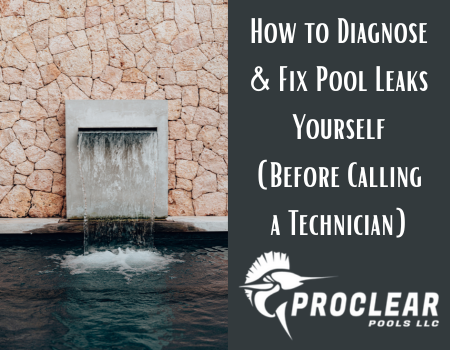 A pool leak can mean higher water bills, damaged decks, and stressed equipment. Before you call a technician, you can run through a few deliberate checks to find common leak sources and apply straightforward fixes. This guide walks you through step-by-step DIY pool leak detection and practical pool leak repair tips to help you stop small problems early.
A pool leak can mean higher water bills, damaged decks, and stressed equipment. Before you call a technician, you can run through a few deliberate checks to find common leak sources and apply straightforward fixes. This guide walks you through step-by-step DIY pool leak detection and practical pool leak repair tips to help you stop small problems early.
Safety first
Turn off pool equipment and any nearby electrical circuits before working near the pump, heater, lights, or wiring. If you suspect a leak near electrical components, do not attempt repairs yourself. Call a licensed pro.
Quick reality check
- Measure normal loss. A typical pool will lose some water to evaporation. Use a straight-edge ruler or a water level chart to track daily loss for three days at the same time. Evaporation is usually under 1/4 inch per day. If you lose more, you probably have a leak.
- Check for patterns. Rapid loss only when the pump runs usually means a pump, filter, or suction-side plumbing issue. Slow, steady loss suggests shell leaks, return fittings, or light fixtures.
Step-by-step DIY pool leak detection
1. The bucket test
What it reveals: whether the loss is evaporation or a leak.
- Fill a bucket with water and place it on the pool step so the water level in the bucket matches the pool water line. Mark both levels.
- Leave for 24 hours without running equipment.
- If pool water drops more than the bucket water, you have a leak.
2. Run-versus-off test
What it reveals: whether the leak is related to circulation equipment.
- Run the pump for several hours and note water loss per hour.
- Turn pump off for several hours and note the loss.
- If loss is significantly greater while the pump runs, suspect pump, filter, heater, chlorinator, or suction-side plumbing.
3. Inspect visible equipment
What to look for: drips, wet soil, corrosion, loose fittings.
- Check pump lid O-ring and union fittings for leaks where pipes join.
- Inspect the filter housing, heater connections, salt cell, and chemical feeders.
- Tighten loose unions and replace cracked fittings or damaged O-rings. Keep a small parts kit with spare O-rings and hose clamps.
4. Dye and visual tests for shell leaks
What it reveals: leaks around skimmers, lights, returns, tile line, fittings.
- Turn off water circulation. Using a syringe or dye bottle, squirt a few drops of pool-safe dye near suspected areas (skimmer throat, around lights, tile grout, returns).
- Watch whether the dye is pulled into a crack or seam, indicating a leak path.
5. Check returns and skimmers
What to look for:
- Remove return eyeballs and check threads and pipes behind them.
- Inspect skimmer weir, throat, and liner around the skimmer for gaps. Tighten skimmer faceplate bolts if loose.
6. Monitor pool plumbing leak clues
What to know: plumbing leaks under deck or underground are hard to fix alone.
- Look for wet soil, sinkage, or unexpectedly lush patches of grass near equipment.
- If the leak appears to be in buried PVC or under the shell, note the location and call a pro if you cannot access it.
DIY pool leak repair tips
Small fixes you can do yourself
- Replace pump lid O-ring and lubricate with silicone lube to stop leaks at the pump.
- Tighten or replace union fittings and clamps.
- Patch vinyl liners with a manufacturer kit following instructions and letting patch fully cure before refilling.
- Replace a cracked return eyeball or skimmer faceplate.
- Re-seat or replace light niche gaskets if accessible and the light is low-voltage; if wiring is involved, hire an electrician.
When to use professional help
- Underground piping leaks or leaks beneath the shell.
- Large leaks that drop several inches per day.
- Structural cracks in concrete or shotcrete shell.
- Any leak that involves electrical gear or the heater body.
Professionals have tools like pressure testing kits, leak dye cameras, and underwater epoxy systems.
Preventive steps to reduce future leaks
- Keep unions and O-rings lubricated and replace annually.
- Winterize equipment if you seasonally shut down.
- Maintain balanced water chemistry to reduce corrosion and material degradation.
- Inspect your equipment pad and plumbing annually for wear.
Final checklist before you call the technician
- Did the bucket test confirm a leak?
- Did loss change when the pump was running?
- Have you fixed or replaced simple items like O-rings, unions, and return eyeballs?
- Can you narrow the probable area (equipment, skimmer, return, underground)?
If you have exhausted DIY options or the leak is large or near wiring, share your findings with the technician. Providing test results and the suspected area will speed diagnosis and save on service time.
With careful DIY pool leak detection and basic pool leak repair tips, many small leaks can be found and fixed quickly. That saves water, protects your pool structure, and buys you time before calling a professional for larger jobs.
